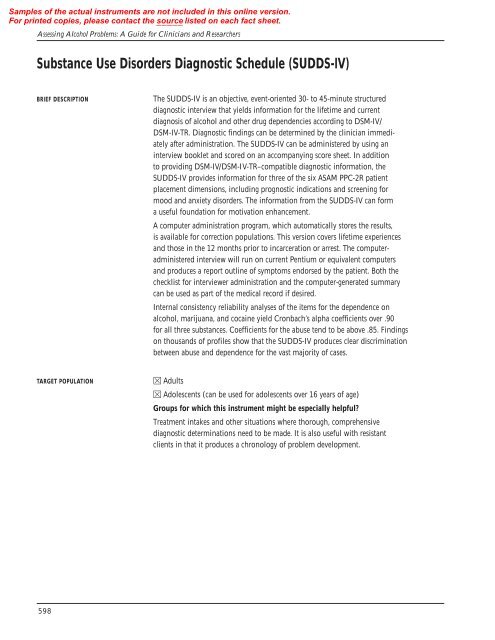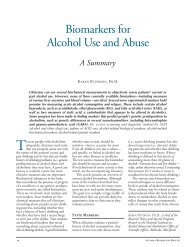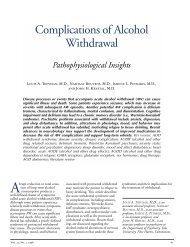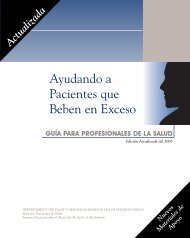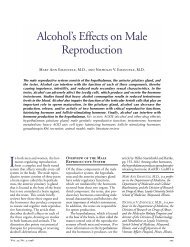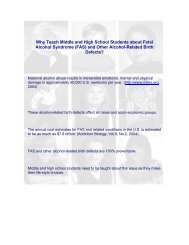Substance Use Disorders Diagnostic Schedule (SUDDS-IV)
Substance Use Disorders Diagnostic Schedule (SUDDS-IV)
Substance Use Disorders Diagnostic Schedule (SUDDS-IV)
You also want an ePaper? Increase the reach of your titles
YUMPU automatically turns print PDFs into web optimized ePapers that Google loves.
Samples of the actual instruments are not included in this online version.<br />
For printed copies, please contact the source listed on each fact sheet.<br />
Assessing Alcohol Problems: A Guide for Clinicians and Researchers<br />
<strong>Substance</strong> <strong>Use</strong> <strong>Disorders</strong> <strong>Diagnostic</strong> <strong>Schedule</strong> (<strong>SUDDS</strong>-<strong>IV</strong>)<br />
BRIEF DESCRIPTION<br />
TARGET POPULATION<br />
598<br />
_____<br />
The <strong>SUDDS</strong>-<strong>IV</strong> is an objective, event-oriented 30- to 45-minute structured<br />
diagnostic interview that yields information for the lifetime and current<br />
diagnosis of alcohol and other drug dependencies according to DSM-<strong>IV</strong>/<br />
DSM-<strong>IV</strong>-TR. <strong>Diagnostic</strong> findings can be determined by the clinician immediately<br />
after administration. The <strong>SUDDS</strong>-<strong>IV</strong> can be administered by using an<br />
interview booklet and scored on an accompanying score sheet. In addition<br />
to providing DSM-<strong>IV</strong>/DSM-<strong>IV</strong>-TR–compatible diagnostic information, the<br />
<strong>SUDDS</strong>-<strong>IV</strong> provides information for three of the six ASAM PPC-2R patient<br />
placement dimensions, including prognostic indications and screening for<br />
mood and anxiety disorders. The information from the <strong>SUDDS</strong>-<strong>IV</strong> can form<br />
a useful foundation for motivation enhancement.<br />
A computer administration program, which automatically stores the results,<br />
is available for correction populations. This version covers lifetime experiences<br />
and those in the 12 months prior to incarceration or arrest. The computeradministered<br />
interview will run on current Pentium or equivalent computers<br />
and produces a report outline of symptoms endorsed by the patient. Both the<br />
checklist for interviewer administration and the computer-generated summary<br />
can be used as part of the medical record if desired.<br />
Internal consistency reliability analyses of the items for the dependence on<br />
alcohol, marijuana, and cocaine yield Cronbach’s alpha coefficients over .90<br />
for all three substances. Coefficients for the abuse tend to be above .85. Findings<br />
on thousands of profiles show that the <strong>SUDDS</strong>-<strong>IV</strong> produces clear discrimination<br />
between abuse and dependence for the vast majority of cases.<br />
� Adults<br />
� Adolescents (can be used for adolescents over 16 years of age)<br />
Groups for which this instrument might be especially helpful?<br />
Treatment intakes and other situations where thorough, comprehensive<br />
diagnostic determinations need to be made. It is also useful with resistant<br />
clients in that it produces a chronology of problem development.
ADMINISTRAT<strong>IV</strong>E ISSUES Number of items: 64<br />
Number of subscales: 10<br />
Format(s): □ Pencil-and-paper self-administered<br />
� Interview<br />
□ Observation<br />
� Computer self-administered<br />
□ Other<br />
Time required for administration: 30 to 45 minutes<br />
<strong>Substance</strong> <strong>Use</strong> <strong>Disorders</strong> <strong>Diagnostic</strong> <strong>Schedule</strong> (<strong>SUDDS</strong>-<strong>IV</strong>)<br />
Administered by: Trained chemical dependency professional or patient<br />
Training required for administration? � yes □ no (professionals can self-train)<br />
Comments: Technicians can be trained to administer the <strong>SUDDS</strong>-<strong>IV</strong>.<br />
Continuing education workshops on the <strong>SUDDS</strong>-<strong>IV</strong> and related<br />
assessment topics are available from the instrument distributor.<br />
SCORING Time required to score/interpret: 5 to 15 minutes depending on extent of findings<br />
Scored by: Clinician or computer<br />
Scoring key? � yes □ no<br />
Computerized scoring or interpretation available? � yes □ no<br />
(for computer administration)<br />
Norms available? □ yes □ no (see comments below)<br />
Instrument normed on subgroups? □ yes □ no (see comments below)<br />
Comments: The <strong>SUDDS</strong>-<strong>IV</strong> is based on the diagnostic criteria of the<br />
DSM-<strong>IV</strong>. Although this precludes technical norming on<br />
subgroups, the interview has been found to produce equally<br />
definitive distinctions among no diagnosis, abuse, and dependence<br />
on both genders and for ethnic groups such as African<br />
Americans, Native Americans, and Hispanics/Latinos.<br />
PSYCHOMETRICS Have reliability studies been done? � yes □ no<br />
What measure(s) of reliability was used?<br />
□ Test-retest<br />
� Split half<br />
� Internal consistency<br />
Have validity studies been done? � yes □ no<br />
What measures of validity have been derived?<br />
� Content<br />
� Criterion (predictive, concurrent, “postdictive”)<br />
� Construct<br />
Has factor analysis been done? � yes □ no<br />
599
Assessing Alcohol Problems: A Guide for Clinicians and Researchers<br />
CLINICAL UTILITY OF INSTRUMENT<br />
RESEARCH APPLICABILITY<br />
SOURCE, COST AND COPYRIGHT ISSUES<br />
SOURCE REFERENCES<br />
600<br />
The interviewer- and computer-administered <strong>SUDDS</strong>-<strong>IV</strong> interviews provide<br />
a complete diagnostic assessment to make an accurate DSM-<strong>IV</strong> diagnosis<br />
of substance abuse/dependence. The extent and nature of the diagnostic<br />
indicators also provide information for determining scope of involvement<br />
and stage of illness constructs. Relapse risk indicators and other treatment<br />
planning and placement information compatible with three dimensions<br />
of the ASAM PPC-2R are included.<br />
Both the interviewer- and computer-administered <strong>SUDDS</strong>-<strong>IV</strong> would serve<br />
as accurate dependent variable criteria in a criterion-related validity study,<br />
as an independent variable to classify/screen subjects in an experimental<br />
randomized design, and/or as an independent predictor variable in a multivariate<br />
correlational analysis. The <strong>SUDDS</strong>-<strong>IV</strong> can be used to verify that subjects<br />
met substance use disorder diagnostic criteria for study inclusion or exclusion.<br />
Copyright: � yes □ no<br />
Cost: See below.<br />
Interested persons who are qualified professionals may call, fax, e-mail<br />
or write to Evince Clinical Assessment requesting ordering information.<br />
Current prices are as follows:<br />
Manual, $10.00<br />
Packet of 25 interviews, $62.50<br />
Introductory kit (manual plus 5 interviews), $23.00<br />
Substantial discounts are available for large purchases. Contact Evince<br />
Clinical Assessments for rates on the automated corrections version.<br />
The <strong>SUDDS</strong>-<strong>IV</strong> is copyrighted and may not be reproduced or adapted in<br />
any form, in whole or in part, by any means.<br />
Source: Evince Clinical Assessments<br />
PO Box 17305<br />
Smithfield, RI 02917<br />
Phone: 401-231-2993 or 800-755-6299<br />
Fax: 401-231-2055<br />
E-mail: evinceassessment@aol.com<br />
Harrison, P.A. & Hoffmann, N.G. (1995, 2001). <strong>SUDDS</strong>: <strong>Substance</strong> <strong>Use</strong> Disorder<br />
<strong>Diagnostic</strong> <strong>Schedule</strong> Administration Guide. Smithfield, RI: Evince Clinical Assessments.<br />
Hoffmann, N.G. & Harrison, P.A. (1995). <strong>SUDDS</strong>-<strong>IV</strong>: <strong>Substance</strong> <strong>Use</strong> Disorder<br />
<strong>Diagnostic</strong> <strong>Schedule</strong>-<strong>IV</strong>. St. Paul, MN: New Standards, Inc.
<strong>Substance</strong> <strong>Use</strong> <strong>Disorders</strong> <strong>Diagnostic</strong> <strong>Schedule</strong> (<strong>SUDDS</strong>-<strong>IV</strong>)<br />
SUPPORTING REFERENCES Hoffmann, N.G, DeHart, S.S. & Campbell, T.C. (in press). Dependence:<br />
Whether a disorder or a disease; it is not a “concept.” Journal of Chemical<br />
Dependency Treatment.<br />
Hoffmann, N.G. & Hoffman, T.D. (2003). Construct validity for alcohol dependence<br />
as indicated by the <strong>SUDDS</strong>-<strong>IV</strong>. <strong>Substance</strong> <strong>Use</strong> & Misuse, 38(2),293-306.<br />
Hoffmann, N.G. (2002). Annual Report 2001: Diagnosis of <strong>Substance</strong> <strong>Use</strong><br />
<strong>Disorders</strong> Report prepared for the Minnesota Department of Corrections.<br />
Smithfield, RI: Evince Clinical Assessments.<br />
Davis, L.J., Hoffmann, N.G., Morse, R.M. & Luehr, J.G. (1992). <strong>Substance</strong> <strong>Use</strong><br />
Disorder <strong>Diagnostic</strong> <strong>Schedule</strong> (<strong>SUDDS</strong>): The equivalence and validation of a<br />
computer administered and an interviewer-administered forma. Alcoholism:<br />
Clinical and Experimental Research, 16(2), 250-254.<br />
FOREIGN LANGUAGE VERSIONS AND HOW TO OBTAIN<br />
Danish, Norwegian, Contact Evince Clinical Assessments.<br />
and Swedish<br />
601


